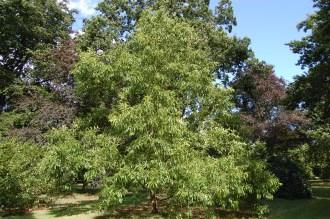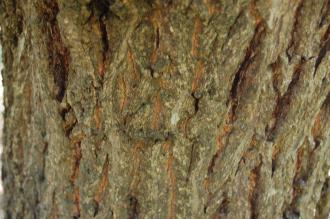
Quercus acutissima (17/08/2014, Kew Gardens, London)
Position: Sun to light shade
Flowering period: Spring
Soil: Moist, well drained
Eventual Height: 30m
Eventual Spread: 30m
Hardiness: 5b, 6a, 6b, 7a, 7b, 8a, 8b, 9a
Family: Fagaceae
Quercus acutissima is a deciduous tree with a pyramidal crown that rounds with age. Its shiny mid green leaves are narrowly elliptic with saw tooth serrated margins, up to 20cm long and 6cm broad. Its leaves turn yellow/ brown in autumn before they fall. Its trunk may achieve a diameter of 1.5m. Its gray bark is deeply furrowed when mature. Its flowers are wind pollinated catkins. Its fruit are acorns which are up to 3cm long and 2cm broad.

Quercus acutissima Leaf (17/08/2014, Kew Gardens, London)
Quercus acutissima, commonly known as the Sawtooth Oak, is native to China, Korea and Japan. In its native habitat it grows in mountainous deciduous forests.
The etymological root of the binomial name Quercus is derived from the Latin name for an Oak tree; some authorities derive the word from Celtic, quer, fine and cuez, a tree. Acutissima is derived from the Latin acutus meaning ‘cut to a point’.
The landscape architect may find Quercus acutissima useful as a tree for planting in the urban environment as it is tolerant of compaction and atmospheric pollution. Once established this tree is drought tollerant.

Quercus acutissima Bark (17/08/2014, Kew Gardens, London)
Ecologically, Quercus acutissima acorns are eaten by birds and mammals.
Quercus acutissima prefers moist, fertile, well-drained soils. It tolerates most pH of soil.
Quercus acutissima requires little maintenance.

